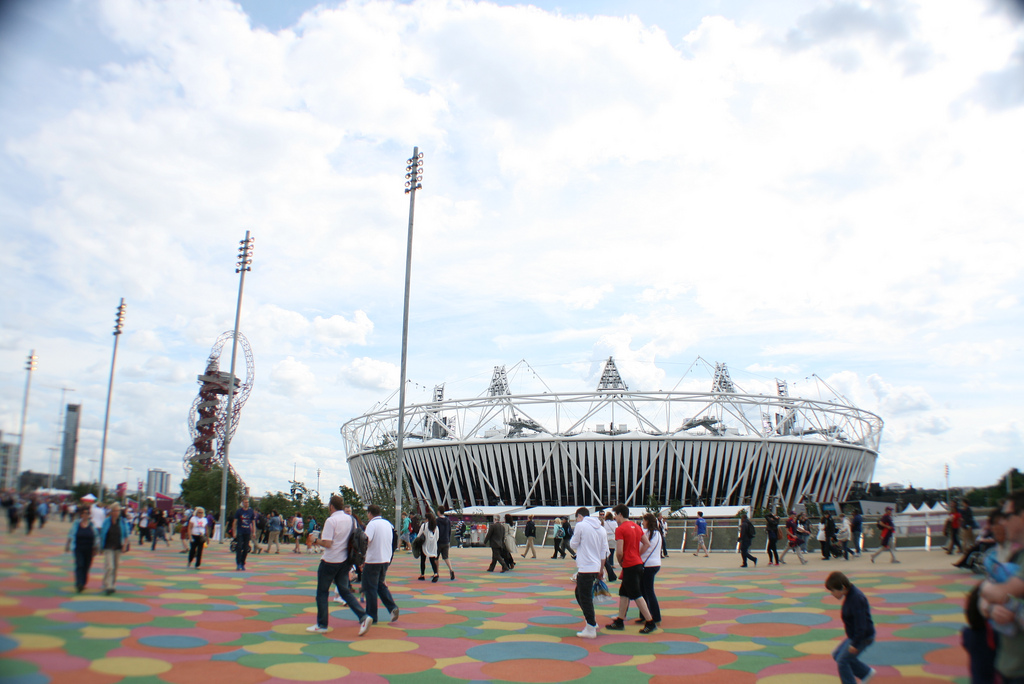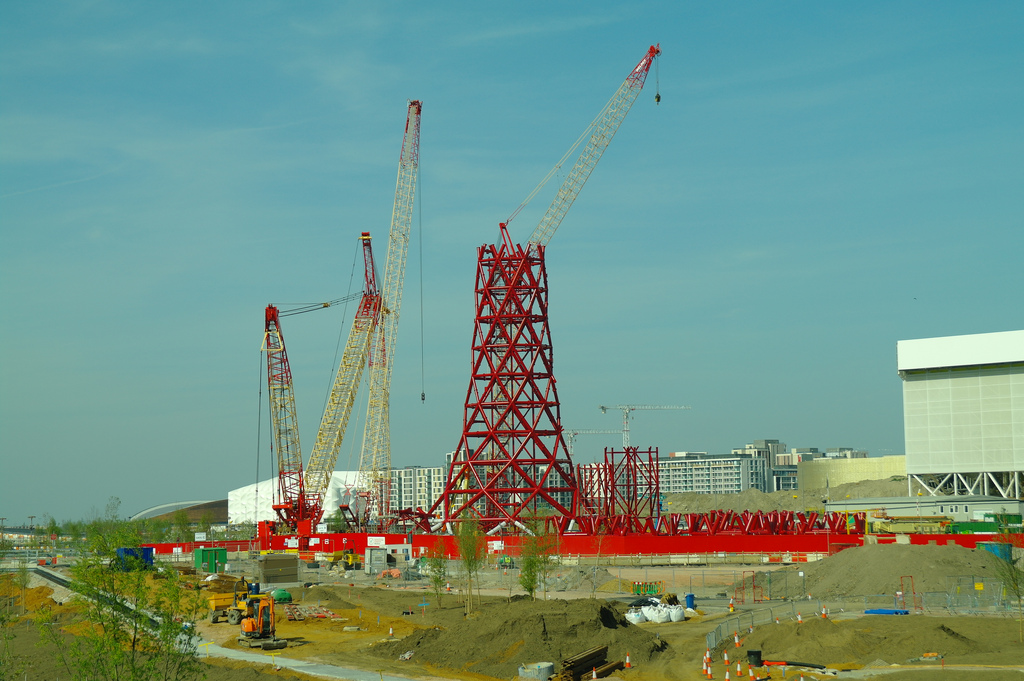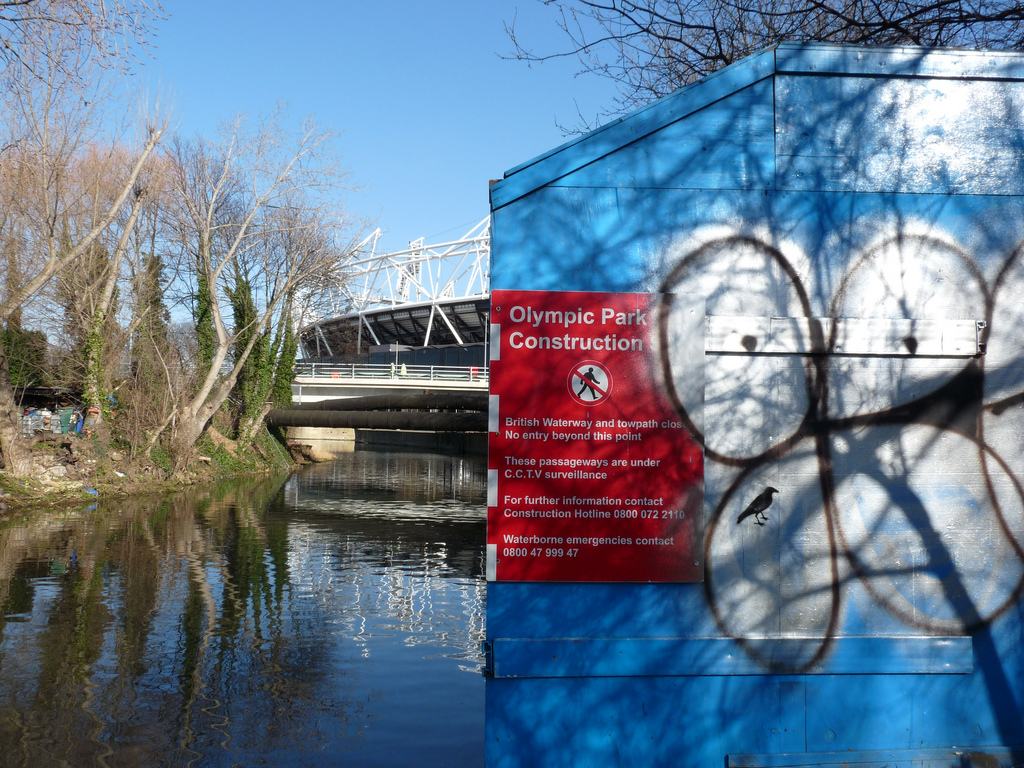Private vs. public: mega events, human rights and the London Olympics


A flame burns in a gigantic cauldron above the city. Men in orange overalls peel plastic covers back from rows of glistening multicoloured seating. Officials patrol the streets in sunglasses. Sponsor cars with dark windows glide silently along windless roads, and shiny hotels welcome tourists on the trip of a lifetime. An aerial view of the city reveals a network of green sports grounds, neat pedestrian walkways and illuminated entertainment zones. A woman in a tracksuit and earpiece stands outside the gates of the athletes’ village. A pigeon lands next to her feet. She moves it on.
The media centre and swimming pool are built on land that until recently was home to a community of squatters and artists, as well as the city’s largest housing support service. Soon after the city won its bid for the Games, the council began to sweep out the community. Each week, hundreds were pushed to the outer limits of the city with a warning not to return. The ‘Possession of Public Spaces Act’ passed without debate. Bulldozers mowed to dirt all traces of the community. One morning, new street signs appeared: Victory Way, Gold Street, Olympic Avenue. The pigeon returns, shits on a new, bright blue rubbish bin, and flies away. There’s nothing for it here.
This imagined scene is reminiscent of many urban landscapes transformed by mega events. As London hosts the Olympics, it’s timely to consider the impact of these events on the rights of urban citizens in host cities. While mega events have both positive and negative impacts, in particular on the right to housing, they are also an opportunity to enhance the realisation of human rights.
The mega event
A mega event is a large-scale sporting or social event, best represented by the Olympics, but equally includes world fairs and international conferences. In the last half century, mega events have become more than celebrations of sport and culture. The contemporary approach of cities and states is to view the staging of international events as part of their economic development strategy, involving renewal of urban infrastructure and real estate investment. Cities vie for prestige with architecture by leading designers – perhaps best exemplified by Beijing’s ‘bird’s nest’ by Herzog and de Meuron and artist Ai Wei Wei in 2008. Host cities see mega events as key to repositioning themselves in the globalised market economy.
Mega events are often the catalyst for new development, urban regeneration, upgrading and beautification projects, and the adoption and implementation of housing plans. They attract public and private investment. Host cities see unprecedented levels of construction in inner and peripheral areas. This generates new business and employment opportunities, increased traffic; demand for services and public transport, as well as changes in population demographics, cost of living, environment and air quality.

Some of this may have positive impacts on citizens’ rights, including increased access to work and general economic benefit. However, the negative impacts of mega events on citizens’ rights, and on the city’s capacity to realise citizens’ rights, are more numerous.
Negative impacts of mega events on human rights
The short-term negative impacts include closure of local amenities, disruption of public transport and event-related construction work. Transient contract worker populations also place strain on limited facilities and alter the composition of community. All of this can produce a sort of ‘neighbourhood shock’ in host cities.
More permanent concerns arise from the spatial transformations of the city that mega events cause. Chiefly, repossession of land for constructing event venues results in the eviction of citizens from their homes and the displacement of whole families and communities. Generally, compensation – if any – is inadequate to replace property and less quantifiable social goods, such as community, belonging and familiarity.
Secondary affects of the spatial transformations of host cities include: rent hikes for citizens who choose to remain in their homes during the event; escalating living costs; decrease in availability of social and low cost housing; the criminalisation of homelessness; and discrimination against the poor. Beautification and regeneration projects also catalyze spikes in inequality by pushing marginalised and disadvantaged people to the geographic and social limits of the city. At the same time the young, wealthy and upwardly mobile concentrate in inner urban, new-build ghettos.
Rights of urban citizenship and the deterioration of civic values
The social fabric of communities has the potential to be torn, rather than strengthened in host cities. Most at risk of deterioration are the rights of urban citizenship and civic values.
In the context of mega events, rights to participation and information are paramount. However, citizens typically have few opportunities to help in the design, planning and staging of mega events. Their lives and livelihood are affected by the decisions of technocrats (with vested interests in seeing the event go ahead without disruption from pesky locals). Significantly, these players have little or no ties to the community and are therefore insulated from the negative impacts of the mega event. However, London’s experience may show that this is changing, albeit minimally. The London Olympic Authority engaged in public consultation concerning its Games transport strategy and back in 2007, the Olympic Delivery Authority (ODA) hosted a 5-week planning consultation period with local residents.
More concerning during the spatial transformation of host cities is the reconfiguration of the dynamics of power. In particular, private development reduces the space available for citizens’ democratic participation in decisions shaping their experience of freedom. The interaction between city design and the creation and control of citizenship and citizens’ rights has long been recognised, as has the constitutive relationship of environment and individual liberty. In addition to limits on citizens’ political rights to move freely, associate and protest, mega events also curb freedom of expression by implementing tougher penalties for graffiti and busking for the duration of the event.
A more subtle impact is the erosion of civic values that mega events precipitate. While mega events can raise short-term pride in the citizens of host cities, they are more likely to breed resentment among citizens. Dramatic demographic and spatial transformations are effected by mega events. Social divisions are enlarged – solidarity, trust and overall safety are reduced.

A rationale of exception?
As mega events draw near, the situation of vulnerable people deteriorates. In some cases, host cities have introduced ‘exceptional’ laws to remove ‘unsightly’ groups from public spaces. For example, prior to the Sydney Olympics, aboriginal people were moved from areas around venues to ‘beautify’ the city.
Policies and special laws designed to ‘cleanse’ the city by relocating people discriminates against low-income populations, ethnic minorities, the elderly and the disabled. Typically, the special laws empower authorities to push vulnerable people to the outskirts of the city, with no prior consultation, notice, or opportunity for review (and often without alternative accommodation or adequate compensation). During Barcelona’s 1992 Olympics, homeless people were removed from the city; in 2004 in Athens, Roma communities were the main target of displacement; and in the Beijing Games in 2008, the majority of evictees were migrant workers.
The criminalisation of homelessness, street sleeping and conducting business in public places tend to affect groups who are most dependent on public spaces for their livelihood. In preparation for the 2002 Football World Cup in Seoul, local authorities created a list of places where homeless people were banned. During the 1996 Atlanta Olympics, homelessness was made illegal – over 9000 citations were issued against homeless people. Street vendors, sex workers, beggars, young people and migrants are also targets. The ‘rationale of exception’ used to justify these measures is dangerous. In the short term, these laws feed a culture of discrimination and generate a negative human rights legacy. Civic rights, freedoms and standards of public life are severely restricted. The danger with these laws is that they threaten to become the norm – the ‘exception’ becomes the rule.
(Lack of) accountability
Our silence on the negative impacts of mega events is striking. Partly, this is due to the ‘greyness’ of accountability for human rights. Who is responsible for protecting citizens’ rights? Host cities? The state? Individuals? Private corporations? Partners? Sponsors? It’s clear that states have human rights obligations under international law, and that individuals and the private sector can be held to account under domestic law. However, host cities are rarely considered legal entities and their actions go unchecked. The human rights impacts of mega events are swept under the rug.
Legal standards
In 1999, the International Olympic Committee adopted the Olympic Movement Agenda 21 – Sport for Sustainable Development. The agenda applies in the context of Olympic Games and aims to combat social exclusion and promote sports infrastructure better suited to social needs. In 2000, the Sydney Olympic Park Authority adopted a Protocol for Homeless People in Public Places in time for the games. The protocol is designed ‘to help ensure that homeless people are treated appropriately and receive services if they need, or request them.’ The protocol is meant to ‘balance’ people’s right to be in public places with respect for the right of local communities to live in a safe and peaceful environment. Yet, in the notoriously slippery parlance of ‘balance’, the conditions for achieving the goals of the protocol are vague, leaving open the potential for bureaucratic tampering.
More recently, Vancouver adopted an Inner-city Inclusive Agreement for the 2010 Winter Olympic Games. This aimed to ensure that the games were environmentally and socially sustainable. The agreement guaranteed that no one would be made homeless as a result of the games, and that the Olympic Village would be transformed into a residential neighbourhood with 250 units assigned to non-market housing. Similarly, South Africa’s 2010 world cup agenda included development initiatives to improve the lives of the most disadvantaged, such as introducing sporting programs in disadvantaged neighbourhoods, improving medical services and developing community art centres. Rio’s 2016 Olympic Games bid includes proposals for improving and relocating informal housing settlements (however, there have already been reports of threatened eviction).
These local initiatives, while praiseworthy, fail to address human rights explicitly. To ensure that host cities and others responsible for mega events act in conformity with human rights standards, it is important that these are addressed clearly in binding norms.
At the international level, as a result of pressure for action on mega events, some soft law standards have been developed. The most significant among these is the United Nations Human Rights Council’s (HRC) 2010 resolution on the right to adequate housing in the context of mega events. The HRC (as the international community’s chief standard setting body on human rights) called on states, in the context of mega events, to promote the right to adequate housing and to create sustainable, development-oriented housing by:
- Integrating housing concerns into the bidding and planning process at an early stage
- Ensuring transparency of the planning and implementation process and meaningful participation of affected local communities
- Paying particular attention to persons belonging to vulnerable and marginalized groups, respecting the principles of non-discrimination and gender equality
- Planning and developing event venues with the post-event period in view, while taking into account the needs of socially disadvantaged persons for affordable housing
- Ensuring that the right to adequate housing of affected persons is respected, while giving due consideration to issues such as insecurity of tenure
- Exploring alternatives to evictions and to undertake any such evictions as may be necessary in accordance with the domestic legal framework and in full compliance with the relevant provisions of international human rights law, including those for adequate and effective remedies.
The United Nation’s Special Rapporteur on the right to housing, Raquel Rolnik, has also published a report that looks at the impacts of mega events, with even stronger recommendations than the HRC’s. These efforts by the international community are admirable. But with this focus on housing rights, what has failed to be addressed is the impact of mega events on the whole panoply of citizens’ rights – civil, economic, social, cultural and political. However, the Special Rapporteur’s report did raise one idea that could be applied to human rights in the context of mega events more generally. This is the idea of using ‘social impact assessments’ to measure the affect of mega events on the lives of citizens. These are similar to the now-standard environmental impact assessments. The goal of using impact assessment is to stimulate best practice. Applied to mega events, this would help ensure that event planning and staging would meet and exceeds human rights best practice. While London’s bid book for the games canvassed an environmental impact assessment with socio-economic aspects, no attention was paid to the impact of the event on human rights. Nor was an explicit commitment to human rights included.
What would human rights best practice in mega events look like? We can imagine it would include things like designing and constructing venues that facilitate disabled access; employing marginalised people in venue management; ensuring gender equality among event volunteers; and mandating clean air standards to fulfill citizens’ right to a healthy environment.
The idea of human rights-based social impact assessments has so far been little explored. This is disappointing, considering the potential for these to stimulate creative and visionary human rights practice – and to catalyze a shift in the legacy of mega events from building GDP to realising human rights. In the context of sponsor-rich mega events, there is at least no cost barrier to this positive human rights legacy becoming a reality.
A global charter of urban rights?
One idea to help protect and promote citizens’ rights during a mega event is a global charter of urban rights. Such a charter – which as been mooted for some time – could provide guidance to citizens and host cities before, during and after mega events by mandating standards for human rights compliance and monitoring. A global charter of urban rights could also improve awareness of the impact of mega events on citizens’ rights and lead to better outcomes for human rights realisation generally.

The legacy for London
Will London 2012 deliver a positive, human rights legacy? Cheerleading city mayor Boris Johnson promised in his re-election campaign earlier this year that the regeneration of East London for the Olympics would deliver “30,000 new homes, thousands of jobs, shopping centres and business parks”, all of which would be “served by the new transport links and infrastructure connecting brand new communities to the rest of the capital.”
This triumphery clashes with the reality that in the past six years, property values surrounding London games venues have increased by up to 60,000 pounds, sparking speculation of income inequality and driving rich and poor households into segregated neighbourhoods. Boris’ promise is also at odds with a deepening housing crisis in wider London, as well as the increasingly oxymoronic ‘London Living Wage’ initiative and failed attempts to place a cap on rising rents. Unfortunately a displacement trend is already apparent too. Housing charity Shelter reports that the London housing ‘crunch’ has seen landlords evict tenants to price-gouge tourists. Others enforce expensive ‘penalties’ for tenants wanting to stay in their home during the Olympics. Moreover, a number of social housing units have been destroyed in connection with the games and citizens have been displaced from Olympic sites. In some cases, displaced residents have been resettled. For example, the London Development Agency has built new sites to relocate 35 traveller families. But, these families’ ties to existing community, education and opportunity may not be so easily replaced.
London’s bid book did entail several positive commitments. These include limiting construction of new venues to avoid disrupting existing housing stock, which effectively reduces the number of forced evictions; devoting 50 per cent of new dwellings to social housing; and constructing a number of community facilities. These are welcome commitments considering the historic deprivation of investment in the East London area. But whether London can be held to account for these on-paper commitments is yet to be seen.
Photography by Marcus Mo, Megoizzy and Martin V. Morris sourced via Flickr with cc-licensing